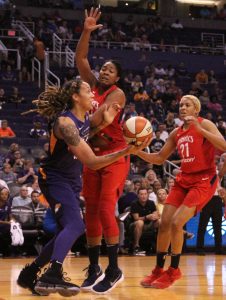- Slug: Sports- WNBA low-post. 874 words
- Photo available
By NATE FAIN
Cronkite News
PHOENIX — The Minnesota Lynx and Phoenix Mercury will play on Friday in a game that will look like a blast from basketball’s past, as Sylvia Fowles and Brittney Griner wage war on the low block.
It’s a rematch of a June 1 showdown in Minnesota. The Mercury won 95-85, but more noticeable than the score was the style in which the game was played.
While basketball leagues across the globe embrace pace and 3-point shooting, post play in the WNBA has never been stronger.
“I’m usually on the edge of excitement when I get to go against Brittney,” said Fowles, who was held to just 16 points and 11 rebounds against the Mercury three weeks ago. “She’s a really good player, so I always want to bring my best game. Remembering to be smart and confident helps.”
Last season, five of the league’s top six scorers did the majority of their work in the low post, including the league’s leading scorer, Griner, and its Most Valuable Player, Fowles.
This season, newcomers A’ja Wilson and 6-foot-8 Liz Cambage have brought more standout play down low, both in the Top 10 in points per game.
Mercury coach Sandy Brondello said the shift down low has more to do with individual talents than basketball philosophy. NBA centers, like Anthony Davis and Karl-Anthony Towns, are now more versatile and agile than ever, whereas centers in the WNBA are taller and stronger than ever.
“The NBA is so athletic, but every WNBA team now has a big center that they want to play through,” Brondello said. “Dallas, Minnesota, New York, they want to play through the post players. So it’s more about playing to your strengths. I suppose, if NBA teams had Shaq, they’d throw the ball to the post most.”
Fowles and especially Griner once towered over pretty much every center in the league. Now they’re a giants among giants. At least eight WNBA players are 6-6 or taller, which means it’s more important than ever that centers polish their low post moves.
Fowles’ post game is predicated on brute strength. If she’s guarded one-on-one, she lowers her shoulder and bullies her way to the hoop.
Griner, who scored 21 points in Phoenix’s win in Minnesota, is most comfortable using the baseline. On the left block, she uses a drop step. On the right, she floats a soft hook shot that’s impossible to contest.
“When I first got into the league, I really liked Tim Duncan’s game,” Griner said. “The backboard… the glass… just keeping it really effective and fundamental. You don’t need a thousand different moves. I’ve tried to get really good at three moves and then build counters off of those.”
With the surplus of height, WNBA teams are running offenses that many in basketball recently thought were endangered. Phoenix, for example, even runs some sets that closely resemble the once-dominant, now-panned triangle offense.
The triangle offense was staple in the NBA for decades. Phil Jackson won 11 NBA championships, running it in Chicago and Los Angeles. But recently, when he implemented it with the New York Knicks, as the team’s president of basketball operations, it failed miserably, leaving pundits and executives questioning whether the offense could be run with success in a more spread-out, breakneck era of basketball.
It’s a scheme that revolves around the low post. Two guards stand on the strong side of the perimeter, so that the post player can easily pass out of double teams. On the weak side, two other players, usually a shooter and another post player, have plenty of space to operate what’s called “the two-man game,” incase the defense shifts toward strong side of the offense.
“The movement is similar. Sometimes, you want to overload a side sometimes you want to create space. It depends where the trap comes,” Brondello said. “We try to play a chess game. (Brittney) is going to get a lot of attention. But she’s passing out of it well, so as long as we keep the movement going, we’ll be in good shape.”
But the proliferation of low post play in the WNBA doesn’t reflect poorly on players’ ability to shoot 3-pointers or the pace of the games. Since 2005, the average number of threes taken per game by each team has increased by 45 percent, and each team averages 10 more offensive possessions per game.
In fact, Diana Taurasi, the WNBA’s most prominent long-range shooter, said the defensive emphasis that teams have to put on stopping bigs only gives her more opportunities light it up from deep.
“(Brittney) has really made it easy to get better looks,” Taurasi said. “When she gets it going, teams really have to pick their poison, and the offense we run really suits that.”
Minnesota exemplifies the inside-out game Taurasi talked about. The Lynx system looks like the offense Shaquille O’Neal and an array of three-point shooters for the Orlando Magic road to the 1995 NBA Finals. Fowles dutifully plays the role of O’Neal.
“I like having that extra space to work,” Fowles said. “When I’m open, they make sure they get me the ball. When they’re open, I make sure to kick the ball back out. We try to make sure that combination is balanced.”
For more stories from Cronkite News, visit cronkitenews.azpbs.org.
